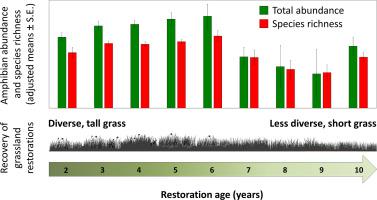当前位置:
X-MOL 学术
›
Ecol. Eng.
›
论文详情
Our official English website, www.x-mol.net, welcomes your
feedback! (Note: you will need to create a separate account there.)
Salvaging bycatch data for conservation: Unexpected benefits of restored grasslands to amphibians in wetland buffer zones and ecological corridors
Ecological Engineering ( IF 3.9 ) Pub Date : 2020-06-01 , DOI: 10.1016/j.ecoleng.2020.105916 Béla Mester , Csaba Szepesváry , Márton Szabolcs , Edvárd Mizsei , Thomas Oliver Mérő , Kristóf Málnás , Szabolcs Lengyel
Ecological Engineering ( IF 3.9 ) Pub Date : 2020-06-01 , DOI: 10.1016/j.ecoleng.2020.105916 Béla Mester , Csaba Szepesváry , Márton Szabolcs , Edvárd Mizsei , Thomas Oliver Mérő , Kristóf Málnás , Szabolcs Lengyel

|
Abstract The degradation and loss of habitats are one of the major causes of the recent global decline of amphibian populations, and wetland ecosystems are increasingly restored to counter these effects. However, there is little information on how restoration of non-wetland habitats such as grasslands affect amphibians in wet-terrestrial habitat complexes. We studied the spatial and temporal impacts of large-scale grassland restoration in wetland buffer zones and ecological corridors on amphibians in Hortobagy National Park (E-Hungary). We used bycatch data on amphibians inadvertently collected over seven years by Barber pitfall trapping in a post-restoration monitoring of invertebrates in restored and natural grasslands. Repeated measures analyses revealed higher abundance and species richness of amphibians from year 2 to 6 after restoration than in years 7 to 10. Early phases of restoration, dominated by weedy and dicotyledonous plants, provided suitable microclimatic refuges and foraging areas to amphibians. The availability of such microhabitats decreased in later phases of restoration, dominated by grasses and a few dicotyledonous plants. Legacy effects were important because fine-scale differences in crop history and seed mixture resulted in variation in total abundance and species richness. Space-for-time substitution analyses two and seven years after restoration also confirmed the temporal differences between early and late phases of restoration. Restored grasslands did not differ from natural grasslands in total abundance, species abundances or species richness of amphibians. Our study demonstrates that increasing the area of grasslands around and among lowland marshes can be an effective tool for conservation because amphibians readily use these areas as refuges or for foraging, movement, migration and dispersal. Restoration of non-wetland habitat can benefit amphibians at the local scale by extending suitable terrestrial habitats and at the landscape scale by establishing functional connectivity between wetlands.
中文翻译:

挽救兼捕数据用于保护:恢复的草原对湿地缓冲区和生态走廊中的两栖动物的意想不到的好处
摘要 栖息地的退化和丧失是近期全球两栖动物数量下降的主要原因之一,越来越多的湿地生态系统正在恢复以应对这些影响。然而,关于草地等非湿地栖息地的恢复如何影响湿地栖息地复合体中的两栖动物的信息很少。我们研究了湿地缓冲区和生态廊道中大规模草地恢复对霍尔托巴吉国家公园(匈牙利)两栖动物的时空影响。我们使用了 Barber 陷阱在七年间无意中收集的两栖动物的兼捕数据,用于对恢复和天然草原中的无脊椎动物进行的恢复后监测。重复测量分析显示,恢复后第 2 年至第 6 年两栖动物的丰度和物种丰富度高于第 7 年至第 10 年。恢复的早期阶段,以杂草和双子叶植物为主,为两栖动物提供了合适的小气候避难所和觅食区。在恢复的后期阶段,此类微生境的可用性下降,主要是草和一些双子叶植物。遗留效应很重要,因为作物历史和种子混合的细微差异导致总丰度和物种丰富度的变化。修复后两年和七年的时空替代分析也证实了修复早期和晚期之间的时间差异。恢复的草原在总量上与天然草原没有区别,两栖动物的物种丰度或物种丰富度。我们的研究表明,增加低地沼泽周围和之间的草原面积可以成为保护的有效工具,因为两栖动物很容易将这些地区用作避难所或觅食、移动、迁徙和扩散。非湿地栖息地的恢复可以通过扩展合适的陆地栖息地在局部尺度上使两栖动物受益,并通过在湿地之间建立功能连通性在景观尺度上使两栖动物受益。
更新日期:2020-06-01
中文翻译:

挽救兼捕数据用于保护:恢复的草原对湿地缓冲区和生态走廊中的两栖动物的意想不到的好处
摘要 栖息地的退化和丧失是近期全球两栖动物数量下降的主要原因之一,越来越多的湿地生态系统正在恢复以应对这些影响。然而,关于草地等非湿地栖息地的恢复如何影响湿地栖息地复合体中的两栖动物的信息很少。我们研究了湿地缓冲区和生态廊道中大规模草地恢复对霍尔托巴吉国家公园(匈牙利)两栖动物的时空影响。我们使用了 Barber 陷阱在七年间无意中收集的两栖动物的兼捕数据,用于对恢复和天然草原中的无脊椎动物进行的恢复后监测。重复测量分析显示,恢复后第 2 年至第 6 年两栖动物的丰度和物种丰富度高于第 7 年至第 10 年。恢复的早期阶段,以杂草和双子叶植物为主,为两栖动物提供了合适的小气候避难所和觅食区。在恢复的后期阶段,此类微生境的可用性下降,主要是草和一些双子叶植物。遗留效应很重要,因为作物历史和种子混合的细微差异导致总丰度和物种丰富度的变化。修复后两年和七年的时空替代分析也证实了修复早期和晚期之间的时间差异。恢复的草原在总量上与天然草原没有区别,两栖动物的物种丰度或物种丰富度。我们的研究表明,增加低地沼泽周围和之间的草原面积可以成为保护的有效工具,因为两栖动物很容易将这些地区用作避难所或觅食、移动、迁徙和扩散。非湿地栖息地的恢复可以通过扩展合适的陆地栖息地在局部尺度上使两栖动物受益,并通过在湿地之间建立功能连通性在景观尺度上使两栖动物受益。











































 京公网安备 11010802027423号
京公网安备 11010802027423号